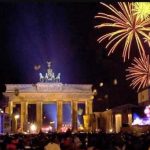
Prosit Neujahr! Happy New Year!
Find out what Germans eat for New Year’s and why!
As much as certain party traditions are faithfully followed in Germany to celebrate New Year’s Eve, the same goes for certain foods that are eaten on “Silvester” (New Year’s Eve) or on New Year’s Day.
It is a tradition to eat well on New Year’s Eve and New Year’s Day. After all, “Wer über die Jahre gut schmaust, hat das ganze Jahr vollauf.” (Who eats well between the year’s end and the new year’s beginning will have a full stomach all year long.)
In parts of Lower Saxony and Schleswig-Holstein, the “Rummelpottlauf” takes place. Children and adults go from house to house singing silly songs and begging for sweets or – if they are adults – for “Schnapps.” The “Rummelpott” is a type of drum which accompanies their singing and keeps the rhythm. It surfaces in this fashion for “Martinstag” and “Karneval” as well. The sweets the children are given vary, but traditionally “Förtchen”, a kind of jelly donut baked in a special pan and similar to the “Pfannkuchen” eaten in Berlin, also known as “Krapfen” or “Berliner” in other parts of Germany.
Some families get together for a “Nachmittagskaffee” on New Year’s Eve to enjoy the last pieces of the Christmas cookies and “Stollen” and “Krapfen.”
 A dinner with interactive food preparation at the table is a prominent and popular past time. These small parties are usually “Fondue,” “Raclette” or “Hot Stone BBQ Parties.” For a more formal event, like a plated dinner, baked carp is traditionally served on New Year’s Eve.
A dinner with interactive food preparation at the table is a prominent and popular past time. These small parties are usually “Fondue,” “Raclette” or “Hot Stone BBQ Parties.” For a more formal event, like a plated dinner, baked carp is traditionally served on New Year’s Eve.
Cheese and meat fondues are the most popular fondue variations on “Silvester.” While cheese fondue is very filling, meat fondue, particularly when cooked in broth rather than oil, is seen as a lighter meal. Small pieces of meat is stuck on the fondue forks and cooked in hot broth or oil ; when done, they are dipped in various sauces to cool the meat and are usually yogurt, tomato or sour cream-based.
“Raclette Sets” often come with an optional hot stone on top, but their main purpose is to melt and broil “Raclette Cheese” in a table-top broiler. The melted cheese is served on top of boiled potatoes, with condiments such as cornichons, pearl onions, pepper, and paprika. Authentic Fondue sets or Raclette sets are available in the U.S. at www.germandeli.com.
Special candies made of almond paste (Marzipan) or figure-shaped bread (“Gebildbrot”) are given to each other as a good luck gift. Common motifs include braids, pretzels, pigs, four-leaf clover, and horseshoes. “Marzipanschweinchen” (almond paste shaped in pig form) or “Marienkäfer” (Lady Bugs) made of chocolate as well as the “Glückspfennig” (lucky penny made of chocolate) and a small four-leaf clover potted plant with a chimney sweeper figurine are supposed to bring luck and wealth in the new year.
No Poultry
Poultry is rarely eaten on New Year’s Eve in Germany. According to a very old superstition, all good luck and happiness will fly away with the bird’s feathers. Despite this belief, people in the Rhine region eat goose (“Neujahrsgans”) on New Year’s Day.
Gotta Have Soup!
Perhaps the most popular New Year’s Eve meal is a bowl of soup: lentil soup (Linsensuppe), pea soup (Erbsensuppe), bean soup (Bohnensuppe), or carrot soup (Möhrensuppe). According to a long-standing tradition, these soups are supposed to bring blessings and wealth for the new year. Also, a fully-eaten bowl of lentil soup (see recipe on opposite side) is supposed to guarantee plenty of small change in one’s pocket.
Salt & Bread
A tradition in Saxony, is to place some salt and bread under a tablecloth on New Year’s Eve and keep it overnight into New Year’s Day. This is believed to prevent any times of hunger in the coming year.
Breads & Cakes
There are many baked goods that are popular for New Year’s Eve. Particularly important is the New Year’s Bread (“Neujahrsbrot”). This is gifted to friends and family as both a symbol and a wish that the receivers have plenty of bread without sickness and sorrow in the coming year. Breads formed like pretzels, braids, and wreaths, are also popular during this time because they are believed to represent togetherness, limitlessness, luck, and blessings.
In diesem Sinne: Alles Gute für 2018!
 We wish our readers a wonderful new year filled with happiness, laughter and success! As the new year comes, GW reflects on how readers like you are the backbone to our magazine and website, and we are filled with gratitude. Cheers to 2018!
We wish our readers a wonderful new year filled with happiness, laughter and success! As the new year comes, GW reflects on how readers like you are the backbone to our magazine and website, and we are filled with gratitude. Cheers to 2018!
All the best,
Your German World Team